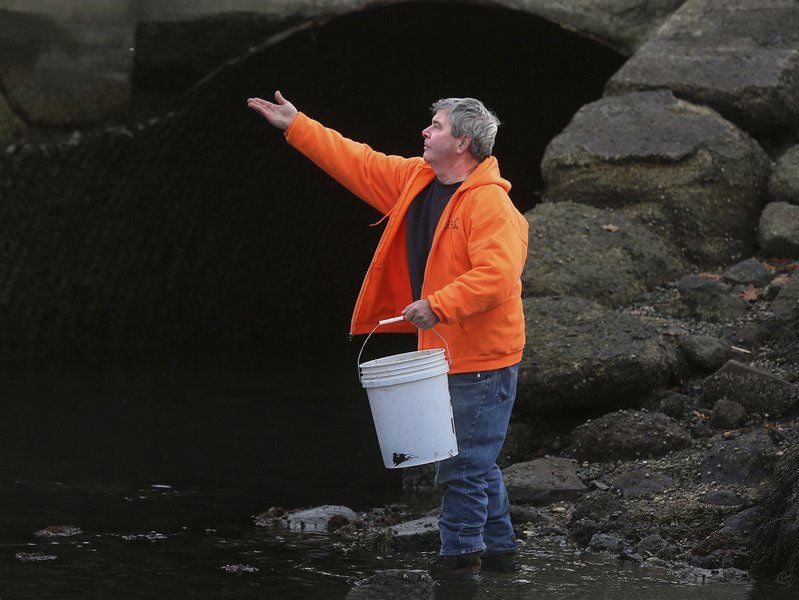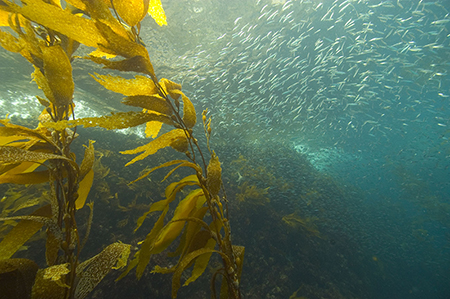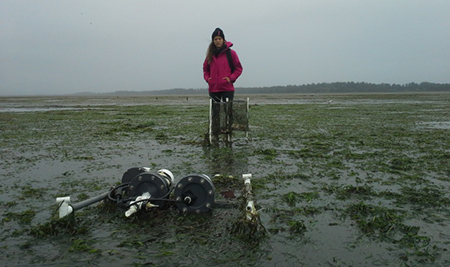
Although the Eastern or American oyster (Crassostrea virginica), a native mollusk with two rough elongated whitish shells, has been declared by many people around New York Harbor to be “functionally extinct”, the bivalve just doesn’t want to give up. In this arm of the ocean, the will to live seems to be strong in the little sea creature.
The evidence for life is among the flotsam and jetsam along the edge of the estuary. Last October, baby oyster larvae, known as spat, were discovered living on a healthy Eastern oyster shell attached to a mushroom anchor in the Navesink River in New Jersey. Farther upstream, in 2013 a large living oyster reef in the Hudson River was removed near the Tappan Zee Bridge before construction began on a new bridge. A three-man crew spent a week removing almost 200,000 oysters near the bridge and sending them to New York City waters at a cost of nearly $100,000.

Perhaps the best sign of recovery came from the tidal waters near the Statue of Liberty in 2016. Oysters can now be found growing in Upper New York Bay. Around the Statue of Liberty are some of the plumpest and fastest growing in the whole of New York Harbor,” according to Peter Malinowski, founder and director of the Billion Oyster Project, a recovery program from the non-profit New York Harbor Foundation that hopes to restore oyster populations throughout the tidal waters of New York City.
Within this program, members have added nearly 50,000 adult oysters in Jamaica Bay, making it the largest single installation for breeding oysters in the city. The program also has over 19.5 million oysters growing in New York Harbor, with 1.05 acres of reef area restored. Albeit a far cry from the 220,000 acres of oyster beds that once existed when Europeans first arrived in 1609, but it’s an important start.
The work seems to be paying off. Remarkably, I’m finding more and more adult oyster shells washed ashore along Raritan Bay and Sandy Hook Bay with juvenile oysters or spat attached to the surface. The other day while walking along the edge of Sandy Hook Bay in Port Monmouth I discovered a large oyster shell about seven inches long with five young oysters or spat fixed to the shell. One of a few notable finds this year.
Will more spat be found on large oyster shells, perhaps as long at 10 or 12 inches? It all depends on how well the ensuing spawning season goes.
Another breeding season begins now, as adult oysters get busy making the next generation. The Eastern oyster has separate sexes, but oysters will always spawn simultaneously, usually in an entire bed of oysters. Both males and females need to live near each other in shallow tidal waters, in depths between 8 to 25 feet, if spawning is to be successful.
Oysters spawn between late June to November, but peak spawning occurs between June and July when water temperatures rise into the 70s. When local estuarine water temperatures rise, an ancient spawning ritual begins.
Mature female oysters release millions of eggs; the males release an even greater number of sperm. In less than 24 hours, the eggs will become fertilized and develop into microscopic free-swimming larvae that look just like specks of black pepper in the water.
A single female Eastern oyster can produce from 75 to 150 million eggs in a single reproductive cycle, but only one in 1,000, less than one percent, will survive to reach the next life stage. It’s not just humans that have found the culinary delights of oysters. Most young oysters will become fish food.
Yet, for those fortunate tiny black specks that do continue, they will spend the next three weeks or so drifting on currents and tides feeding on phytoplankton or microscopic algae. They will develop a thin shell and a slimy foot to help find a location in which to settle down and stick itself in place. It’s a lot of work and stress for a newborn baby to endure, but the hard work will payoff in a good home.
Oyster larvae will eventually attach themselves to a hard bottom substrate, preferably an adult oyster shell where other spat can grow to form a reef, but almost any firm surface will attract a juvenile oyster, such as a brick, an aluminum can, a glass bottle, or even a used porcelain toilet bowl. Once a baby oyster has found a perfect spot, it will secrete a liquid cement-like substance that fixes or glues itself in place to spend the rest of its life in one place.
Most spat are usually males with some individuals transforming into females after the first or second spawning. Oysters may go back and forth between sexes several times during their lifetime. An oyster can live between 10 to 20 years, but most will only survive about four or five years.
It’s not easy being an oyster in New York Harbor. Virus and diseases, including QX oyster disease, are widespread due, in part, to continuing water pollution problems from raw sewage still entering the estuary from antiquated sewage systems. Oysters are more susceptible to disease when they are stressed by poor water quality. There are also plenty of hungry predators, including birds such as the American oystercatcher and gulls, and numerous aquatic dwellers such as oyster drills, sea anemones, sea stars, sea nettles, whelks, mudworms, and cownose rays.
Yet, despite the challenges, the need to bring back oysters to New York Harbor is imperative. When a large number of oysters join together, it's called an "oyster reef.” Oyster reefs are diverse ecosystems that were once found all over the estuary and provided important protection for coastlines from the damaging effects of wave action from storms and nor’easters, they also provided vital habitat and shelter for many marine organisms.
Science has shown that oysters reefs can be similar or just as productive as coral reefs. In one study in Beaufort, North Carolina more than 300 invertebrate species were identified to be living on local reefs. The nooks and crannies of the reef offer habitat to different species of worms, mollusks, fish, and mud crabs. The presence of these organisms attracts larger predators, which in turn attracts even larger predators, all the way up a food chain to humans. The existence of an oyster reef truly creates a dynamic environment.
An oyster reef can also provide refuge from predation for many species, including small clams, grass shrimp, crabs, and worms. More over, oyster reefs stabilize shorelines and help reduce erosion, an increasingly important asset in an ever-warming world.
What’s more, oysters act as a filter to naturally clean up an estuary. Oysters use their gills to absorb oxygen and strain food out of the water. One adult can strain plankton and organic matter at a rate of up to 50 gallons per day (or 1500 times its body volume). A healthy oyster reef contributes significantly to overall water clarity in the estuary. It’s no wonder there is an important project in New York State to bring back a billion oysters into New York Harbor.
Unfortunately in New Jersey, restoration efforts in Raritan Bay and Sandy Hook Bay and surrounding state tidal waters have been put on hold due to the lack of state funds. Let’s hope a new governor, which will be elected this November, will reestablish funds to help return oyster reefs to functioning ecosystems. This will help to improve water quality and benefit fish populations throughout the busy and bustling waters of New York Harbor for many species to enjoy.
To view more pictures, video, or stories of wildlife around Sandy Hook Bay, Raritan Bay, and Lower New York Bay, please visit my nature blog, NY Harbor Nature at
http://www.nyharbornature.com









 Although the Eastern or American oyster (Crassostrea virginica), a native mollusk with two rough elongated whitish shells, has been declared by many people around New York Harbor to be “functionally extinct”, the bivalve just doesn’t want to give up. In this arm of the ocean, the will to live seems to be strong in the little sea creature.
Although the Eastern or American oyster (Crassostrea virginica), a native mollusk with two rough elongated whitish shells, has been declared by many people around New York Harbor to be “functionally extinct”, the bivalve just doesn’t want to give up. In this arm of the ocean, the will to live seems to be strong in the little sea creature.









